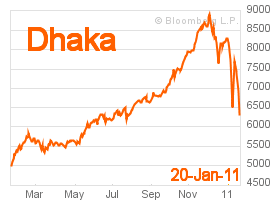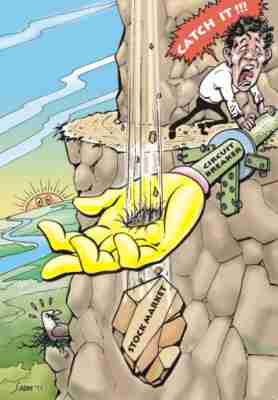
Dynamics

|
Generational Dynamics |
| Forecasting America's Destiny ... and the World's | |
| HOME WEB LOG COUNTRY WIKI COMMENT FORUM DOWNLOADS ABOUT | |
Thousands of investors riot in Dhaka as trading is halted.
 |
 |
Police used batons and tear gas to break up violent protests by hundreds of Bangladesh stock investors, when prices collapsed, halting trading for a fourth day this month, according to Reuters.
This followed a "stupendous fall in share prices" -- 600 points or 9% in just five minutes, according to Financial Express (Dhaka).
There are 3.5 million investors in the Dhaka Stock Exchange (DSE), many of whom have sold their possessions and borrowed as much money as they could to invest in stocks during last year's bubble growth. The stock index took a dip in December, but recovered, and people started pouring money in again. The DSE index fell about 15% in two days, early last week, causing riots and violence among investors.
As we reported last week, the government had attempted to stop the crash by removing all limits on borrowing money to put into the stock market. Stock prices steadied for a few days.
Government officials tried other things as well.
They shortened the trading day, opening at 1:00 pm instead of in the morning, so there's less chance of a crash. I really have to laugh as I type this paragraph, at the thought that shortening the trading day could prevent a crash. In this case, it took only 5 minutes for the index to fall 9%.
 |
Another attempt by the Bangladesh government officials was to institute "circuit breakers." Trading was to be halted automatically if the DSE index fell 225 points, according to the Daily Star (Dhaka).
That didn't work, of course. A full-scale panic occurred, and the index blew past the 225 point circuit breaker much faster than anyone could react.
What's happening in Dhaka these days is very similar to what happened on Wall Street in 1929. The following is taken from my Dow Jones historical page:
Date DJIA (Change) (% of trend) (% of 1929 high)
----------------- -------------- ---------------- ----------------
Mon 1929-10-21 320.91( -3.71%) (213% of 150.23) ( 84% of 1929-09-03)
Tue 1929-10-22 326.51( +1.75%) (217% of 150.25) ( 85% of 1929-09-03)
Wed 1929-10-23 305.85( -6.33%) (203% of 150.26) ( 80% of 1929-09-03)
Thu 1929-10-24 299.47( -2.09%) (199% of 150.28) ( 78% of 1929-09-03) Black Thursday
Fri 1929-10-25 301.22( +0.58%) (200% of 150.30) ( 79% of 1929-09-03)
---------------------------------------------------------------------
Mon 1929-10-28 260.64(-13.47%) (173% of 150.36) ( 68% of 1929-09-03) Black Monday
Tue 1929-10-29 230.07(-11.73%) (152% of 150.38) ( 60% of 1929-09-03)
Wed 1929-10-30 258.47(+12.34%) (171% of 150.40) ( 67% of 1929-09-03)
Thu 1929-10-31 273.51( +5.82%) (181% of 150.41) ( 71% of 1929-09-03) (half-day)
---------------------------------------------------------------------
Mon 1929-11-04 257.68( -5.79%) (171% of 150.49) ( 67% of 1929-09-03)
Wed 1929-11-06 232.13( -9.92%) (154% of 150.53) ( 60% of 1929-09-03)
Thu 1929-11-07 238.19( +2.61%) (158% of 150.55) ( 62% of 1929-09-03)
Fri 1929-11-08 236.53( -0.70%) (157% of 150.57) ( 62% of 1929-09-03)
---------------------------------------------------------------------
Mon 1929-11-11 220.39( -6.82%) (146% of 150.62) ( 57% of 1929-09-03)
Tue 1929-11-12 209.74( -4.83%) (139% of 150.64) ( 55% of 1929-09-03)
Wed 1929-11-13 198.69( -5.27%) (131% of 150.66) ( 52% of 1929-09-03)
Thu 1929-11-14 217.28( +9.36%) (144% of 150.68) ( 57% of 1929-09-03)
Fri 1929-11-15 228.73( +5.27%) (151% of 150.70) ( 60% of 1929-09-03)
---------------------------------------------------------------------
You can see the wild ups and downs, with the up days causing people to think that the worst was over, and the down days generating even more panic. In the period from September 3 to November 15, the market fell 40%.
Wall Street investors today are in dreamland, thinking that they're protected from a similar crash.
In fact, it's much worse in NY than in Dhaka because of of the heavy use of computerized trading. When computers sense a panic, their self-protection algorithms will kick into gear in nanoseconds, and they'll sell off, causing a panic much more rapid than if humans were doing everything. I'm always mindful of the old saying, "To err is human, but to really f--k things up takes a computer."
There's an additional wrinkle about computerized trading that makes this situation even worse for the small investor. You know that when you visit a web site, it can take a few seconds to get a response to a click. Well, that's true of programs, sitting in some stock broker's office, that are supposed to execute your stop order. But those computers will have to wait several seconds to get a response. Meanwhile, the big Wall Street banks have direct network connections into the NY Stock Exchange, and their sell orders will be executed more quickly, by nanoseconds or even seconds. That means that your sell order won't even be processed until the panic has been going on for a while.
From the point of view of Generational Dynamics, the global financial crisis has only begun. Wall Street stocks are overpriced by a factor of almost 200%, as described in "Updating the 'real value' of the stock market." Price/earnings ratios have been well above historic norms continuously for 15 years, since 1995, and by the Law of Mean Reversion, they'll have to be equally below average for roughly 15 years. This means that the stock market will crash to below Dow 3000, and stay there for a long time. The people of Dhaka are learning their lesson now, and it will be the turn of Wall Street investors before long.
It's impossible to predict what will trigger this crash, because there are a number of possibilities. For example, there might be a panic by banks to sell off their shadow inventory of some 8 million foreclosed or troubled homes. Or there might be a collapse of the euro currency, which some mainstream analysts are predicting.
Or, another possibility is that the crash of the Dhaka Stock Exchange will spread to other Asian countries, where there are also huge bubbles, and that could cause a chain reaction that reaches Wall Street within a few months.
(Comments: For reader comments, questions and discussion,
see the 21-Jan-11 News -- Bangladesh stock market crashes 9% in 5 minutes
thread of the Generational Dynamics forum. Comments may be
posted anonymously.)
(21-Jan-2011)
Permanent Link
Receive daily World View columns by e-mail
Donate to Generational Dynamics via PayPal
Web Log Summary - 2016
Web Log Summary - 2015
Web Log Summary - 2014
Web Log Summary - 2013
Web Log Summary - 2012
Web Log Summary - 2011
Web Log Summary - 2010
Web Log Summary - 2009
Web Log Summary - 2008
Web Log Summary - 2007
Web Log Summary - 2006
Web Log Summary - 2005
Web Log Summary - 2004
Web Log - December, 2016
Web Log - November, 2016
Web Log - October, 2016
Web Log - September, 2016
Web Log - August, 2016
Web Log - July, 2016
Web Log - June, 2016
Web Log - May, 2016
Web Log - April, 2016
Web Log - March, 2016
Web Log - February, 2016
Web Log - January, 2016
Web Log - December, 2015
Web Log - November, 2015
Web Log - October, 2015
Web Log - September, 2015
Web Log - August, 2015
Web Log - July, 2015
Web Log - June, 2015
Web Log - May, 2015
Web Log - April, 2015
Web Log - March, 2015
Web Log - February, 2015
Web Log - January, 2015
Web Log - December, 2014
Web Log - November, 2014
Web Log - October, 2014
Web Log - September, 2014
Web Log - August, 2014
Web Log - July, 2014
Web Log - June, 2014
Web Log - May, 2014
Web Log - April, 2014
Web Log - March, 2014
Web Log - February, 2014
Web Log - January, 2014
Web Log - December, 2013
Web Log - November, 2013
Web Log - October, 2013
Web Log - September, 2013
Web Log - August, 2013
Web Log - July, 2013
Web Log - June, 2013
Web Log - May, 2013
Web Log - April, 2013
Web Log - March, 2013
Web Log - February, 2013
Web Log - January, 2013
Web Log - December, 2012
Web Log - November, 2012
Web Log - October, 2012
Web Log - September, 2012
Web Log - August, 2012
Web Log - July, 2012
Web Log - June, 2012
Web Log - May, 2012
Web Log - April, 2012
Web Log - March, 2012
Web Log - February, 2012
Web Log - January, 2012
Web Log - December, 2011
Web Log - November, 2011
Web Log - October, 2011
Web Log - September, 2011
Web Log - August, 2011
Web Log - July, 2011
Web Log - June, 2011
Web Log - May, 2011
Web Log - April, 2011
Web Log - March, 2011
Web Log - February, 2011
Web Log - January, 2011
Web Log - December, 2010
Web Log - November, 2010
Web Log - October, 2010
Web Log - September, 2010
Web Log - August, 2010
Web Log - July, 2010
Web Log - June, 2010
Web Log - May, 2010
Web Log - April, 2010
Web Log - March, 2010
Web Log - February, 2010
Web Log - January, 2010
Web Log - December, 2009
Web Log - November, 2009
Web Log - October, 2009
Web Log - September, 2009
Web Log - August, 2009
Web Log - July, 2009
Web Log - June, 2009
Web Log - May, 2009
Web Log - April, 2009
Web Log - March, 2009
Web Log - February, 2009
Web Log - January, 2009
Web Log - December, 2008
Web Log - November, 2008
Web Log - October, 2008
Web Log - September, 2008
Web Log - August, 2008
Web Log - July, 2008
Web Log - June, 2008
Web Log - May, 2008
Web Log - April, 2008
Web Log - March, 2008
Web Log - February, 2008
Web Log - January, 2008
Web Log - December, 2007
Web Log - November, 2007
Web Log - October, 2007
Web Log - September, 2007
Web Log - August, 2007
Web Log - July, 2007
Web Log - June, 2007
Web Log - May, 2007
Web Log - April, 2007
Web Log - March, 2007
Web Log - February, 2007
Web Log - January, 2007
Web Log - December, 2006
Web Log - November, 2006
Web Log - October, 2006
Web Log - September, 2006
Web Log - August, 2006
Web Log - July, 2006
Web Log - June, 2006
Web Log - May, 2006
Web Log - April, 2006
Web Log - March, 2006
Web Log - February, 2006
Web Log - January, 2006
Web Log - December, 2005
Web Log - November, 2005
Web Log - October, 2005
Web Log - September, 2005
Web Log - August, 2005
Web Log - July, 2005
Web Log - June, 2005
Web Log - May, 2005
Web Log - April, 2005
Web Log - March, 2005
Web Log - February, 2005
Web Log - January, 2005
Web Log - December, 2004
Web Log - November, 2004
Web Log - October, 2004
Web Log - September, 2004
Web Log - August, 2004
Web Log - July, 2004
Web Log - June, 2004